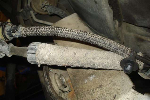hondakillah
Active Member
- Joined
- September 26, 2010
- Messages
- 75
- Reaction score
- 2
- City, State
- Washington State
- Year, Model & Trim Level
- 1994 Limited
1988 Ford Bronco II 2.9L V6
New: FPR, O2, Lower Intake Gasket, Cap, Rotor, Wires, Plugs. Injectors have been cleaned, and do not leak. KOEO Fuel Pressure 35. Vacuum gauge suggests healthy valves and rings.
The engine fires up fine when cold, and idles around 750 RPM. As it starts to warm, it slowly works its way up to 800-850. When the computer reads the engine approaching temperature, the IAC valve kicks open, the engine stumbles, and the computer closes the valve. It does this a couple of times until it finds it's balance. Once it does, the engine idles at 1250 RPM. When I rev the engine, in a futile attempt to kick down the idle, it's a slow set back down to 1250 RPM.
My issue seems like a vacuum leak problem, but I can't find a reasonable place that could be a vacuum leak. That goes to the wayside with the opening of the IAC, and the increased RPMs due to extra air from there; this makes it seem like the computer reading something wrong (thus the new O2 sensor). I bench tested the old O2 sensor, and compared readings to one I had laying around. The old O2 sensor didn't fluctuate as fast as the other one, and figured it wouldn't hurt to replace that one.
Once the engine is warm, and then turned off, I can not restart it until it has cooled enough for whatever to let me restart it with the proper fuel/air ratio. Unplugging the IAC does not help in this situation.
The EGR port into the intake was plugged, but when it was all apart, I cleaned it out.
Where might I be over looking in regards to something that may create a vacuum leak? Is there a sensor I should inspect that may cause false readings to the computer?
New: FPR, O2, Lower Intake Gasket, Cap, Rotor, Wires, Plugs. Injectors have been cleaned, and do not leak. KOEO Fuel Pressure 35. Vacuum gauge suggests healthy valves and rings.
The engine fires up fine when cold, and idles around 750 RPM. As it starts to warm, it slowly works its way up to 800-850. When the computer reads the engine approaching temperature, the IAC valve kicks open, the engine stumbles, and the computer closes the valve. It does this a couple of times until it finds it's balance. Once it does, the engine idles at 1250 RPM. When I rev the engine, in a futile attempt to kick down the idle, it's a slow set back down to 1250 RPM.
My issue seems like a vacuum leak problem, but I can't find a reasonable place that could be a vacuum leak. That goes to the wayside with the opening of the IAC, and the increased RPMs due to extra air from there; this makes it seem like the computer reading something wrong (thus the new O2 sensor). I bench tested the old O2 sensor, and compared readings to one I had laying around. The old O2 sensor didn't fluctuate as fast as the other one, and figured it wouldn't hurt to replace that one.
Once the engine is warm, and then turned off, I can not restart it until it has cooled enough for whatever to let me restart it with the proper fuel/air ratio. Unplugging the IAC does not help in this situation.
The EGR port into the intake was plugged, but when it was all apart, I cleaned it out.
Where might I be over looking in regards to something that may create a vacuum leak? Is there a sensor I should inspect that may cause false readings to the computer?










